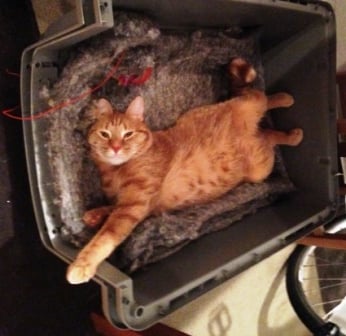Separation Anxiety
How can you help your pet cope with their separation anxiety?
As you prepare for your upcoming journey, life at home looks a little different. New people are coming and going, there are cardboard boxes, suitcases, and the smell of change in the air. This can be downright overwhelming if you have a pet that already struggles with some nervous tendencies!
While there seem to be no hours left in the day to incorporate anything new, here are a few small changes you can make to have a big impact during this transitional period (and the sooner you can start implementing them, the better!)
- Your Attitude Matters: Your pet will always look to you for direction on how to feel about the world around them. As part of the pack, it is a collective effort between you and them to assess the ever-changing environment to decide how to feel about it. Treating the whole process with a “you’ve got this” attitude versus an “I’m sorry this is happening to you” attitude will make a big difference!
- Practice Makes Perfect: Practicing putting your pet in a crate with the door closed for small increments of time while you are home helps make it less of a big deal to go inside when you are not home. The more you can vary the time they are in there, the less of a big deal it becomes. Don’t forget to check out our crate training tips for cats and dogs for more helpful information on getting this started!

- Learn Healthy Separation: For every door that closes, another one opens. If your pet follows you around the house everywhere you go, don’t be afraid to take a moment for yourself and close the door. Whether it be to shower, fold the laundry, or nap. Don’t allow them to be pushy at the door. You deserve a little time to yourself (regardless of how adorable they are!). It will help your pet realize they do not need to be glued to your side every moment you are home.
- Misery Loves Company! Feeding into your pet's stress can make it worse. Put them in a crate or close the door when you leave the house. Try to walk away without saying goodbye (this is not a sad departure, you are about to come right back!). Telling them they are a good boy (or girl) and that you’ll be back makes leaving a big deal, and we want them to understand that it’s not. If they are whining for you when you build healthy separation, try to stop them before it becomes panicky. Don’t be afraid to give them a stern “no”. This can help to show them there is no reason to overreact.
- Be Proactive. Get them used to change before any change happens. Much like people, teaching a pet to be flexible will help them adapt to their upcoming journey and life in a new place. Move their dog bed to a different corner. Feed them in a different space (like inside the crate!) Pull out some boxes and suitcases occasionally, and then put them back. Do a few more car rides than you normally would when you are not going anywhere. The more they get used to seeing and doing these things, and nothing happens, the less of a big deal it becomes and the easier it is to handle.
- Introduce Your Pet to Their New Home Before Moving Day. If possible, take your pet to their new home before you move in. This will help them get familiar with the new environment and feel more comfortable when it's time to move in. Walk them around the house, show them where their food and water will be, and let them explore. This will help reduce anxiety and make the transition smoother.
- Stick to a Routine. Pets thrive on routine, so try to stick to their regular schedule as much as possible. This includes feeding times, exercise, and playtime. Keeping a consistent routine will help your pet feel more secure and reduce stress.
- Take Breaks. Moving can be stressful for everyone, including your pet. Take breaks throughout the day to spend time with your pet and help them feel more comfortable. Take a walk, play fetch, or cuddle on the couch. This will help reduce anxiety and keep your pet happy and healthy during the moving process.

In conclusion, taking the time to prepare your pet for a move can make all the difference in how they handle the transition. By following these tips, you can help reduce their stress and anxiety, and ensure that they thrive in their new home. Remember, your pet looks to you for guidance and support, so approach the moving process with a positive attitude and take steps to make it as smooth as possible for them. With a little extra effort, you can help your furry friend settle into their new surroundings and thrive like the champion they are!
